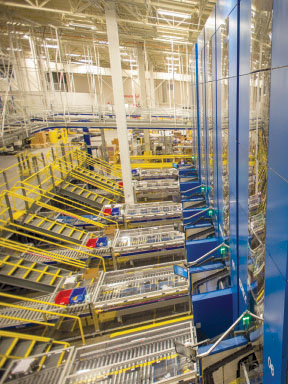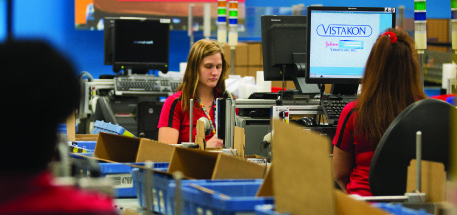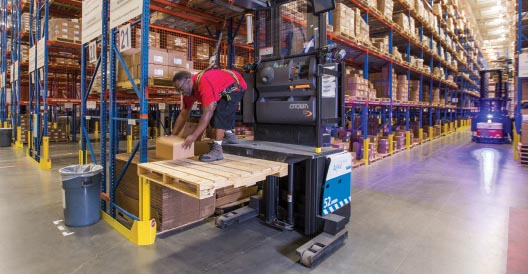At first glance, you may not think a company like Johnson & Johnson Vision Care, which supplies eye care specialists with contact lenses and vision care products, would be concerned about disruption or competition from the likes of Amazon. Lenses, after all, are Class 2 and Class 3 medical devices and even Internet companies specializing in contact lenses must validate a prescription from an eye doctor before they can fulfill an order for a consumer. The business is just different.
Yet, what was once a staid model is changing. For one, the needs of customers have changed: Variety rules the day as the number of SKUs in the space has steadily increased, as has the complexity of the products offered to meet those needs. Meanwhile, the online ordering experience has raised the service level expectations of customers accustomed to ordering from Amazon and its competitors, regardless of the products they are buying or the channels they are buying through. Optical departments at big box retailers as well as private practice opticians are trying to raise their game. And, that is forcing providers of vision care products to up theirs as well.
“Amazon has changed the game for everyone, even on products they don’t sell,” says Fran Mirmina, vice president of customer and logistics services for J&J Vision Care, one of the largest providers of vision care products. “Our vision is to become the best supply chain in the world, keep the customer experience at the forefront of everything we do and continually improve their experience. People are willing to wait for glasses, but when they need contact lenses, they want them right away. If we don’t deliver, our competition will.”

The need for speed to market and mission to supply high-quality products to better the lives of consumers led J&J Vision Care to work with a system integrator (Bastian Solutions to design new processes at its 200,000-square-foot finished goods warehouse and distribution center in Jacksonville, Fla. The processes are as innovative as the products J&J Vision Care is bringing to market. At the highest level, J&J Vision Care has developed a segmented end-to-end supply chain that uses data, connectivity, transparency and partnerships to meet the needs of big box retailers and optical chains; optician and ophthalmologists; and the end customer, all from one facility.
To make that supply chain a reality, J&J Vision Care has implemented some of the world-class solutions being used by leaders in e-commerce fulfillment, such as automated storage and goods-to-person picking solutions.
See the full system layout and processes of the Johnson & Johnson facility.
The new processes and systems were implemented to manage a new line of lenses for consumers with astigmatism. The new solution uses mobile robotic shuttles to retrieve and deliver storage totes to a picking station, where lights and a visual display direct picking. Together, they extend the capabilities of a facility that was already using a set of automated materials handling tools and picking technologies, such as A-frames, vertical lift modules (VLMs), pick-to-light and robotic tote tilters. According to Michael Strong, the worldwide director of engineering and packaging and customer and logistics services, it is an example of how J&J Vision Care rapidly deploys new technologies and processes that will transform its supply chain capabilities as a source of competitive advantage across markets.
“Our approach involves developing internal capabilities as well as leveraging external best-in-class capabilities, and deploying and scaling up quickly in anticipation of the competition,” Strong says.
All told, the system will manage more than 10,000 SKUs when the new product line is rolled out this year. “We already had the bookends of automation with pick-to-light on the low end, A-frames at the high end and vertical lift modules for spare parts and our slowest movers,” Mirmina says. “A goods-to-person picking solution was flexible and modular: It’s going to allow us to get very dense storage for those 10,000 SKUs and allow us to expand for future growth.”
As an added bonus, the system is expected to complement J&J Vision Care’s sustainability initiatives (see box, p. 24).
Evolving needs
As an organization, Johnson & Johnson seeks to “positively impact human health through innovation.” That informs all of the health care giant’s 250 operating companies, including J&J Vision Care, a leader in the third-largest category of health care products, with room to grow.
The vision care franchise is headquartered on a 60-acre campus in Jacksonville that includes the division’s headquarters, research and development, a manufacturing plant and the adjacent DC. According to Mirmina and Strong, the commitment to the consumer and innovation are the foundation of the vision care supply chain, which serves customers in more than 100 countries and includes a second manufacturing plant in Ireland that also ships product to the Jacksonville DC and strategically located DCs around the world. Mirmina describes it as “streamlined and well-connected through a mature S&OP [sales and operations planning] process.”

Not all that long ago, the contact lens segment of the industry was far less complex. When the first disposable contact lens came to market about 25 years ago, there was limited competition and the narrow product line consisted of what is known as spherical lenses, a perfectly round lens that fits on the eye and serves as the basis for vision correction. “Back then, we had virtually 100% market share, about 120 SKUs and fast-moving volume,” Mirmina says. Product was distributed through a channel known as “the three O’s:” ophthalmologists, optometrists and opticians. In a pre-Internet world, where catalog orders took two to six weeks for delivery, speed was less of an imperative.
In recent years, that world has become much more complex and competitive in every respect. The distribution channel was expanded to include at least three segments. First were national retailers as diverse as Pearle Vision Centers, JCPenney, Costco and Walmart. That was followed by the emergence of an e-commerce channel, with players such as 1-800 Contacts. For the “three O’s” to provide the same level of service, lenses are often shipped directly to a patient at the eye doctor’s request.
“Where we used to do primarily loose pick orders to the three O’s, we have added capabilities to pick and ship cases for some of our retail and e-commerce customers,” Mirmina says. “Today, it’s very much an omni-channel operation.”
Those original 120 SKUs expanded to more than 20,000 SKUs as the product line grew to include multi-focal and beauty lenses. The new line of astigmatism products will add an additional 10,000 SKUs for the domestic market. Factor in custom labeling requirements for foreign markets, and J&J Vision Care is managing more than 100,000 SKUs.
Then, there is the need for speed, accuracy and customer service. “At J&J Vision Care, we bring the science and sense of sight to life through world-class innovation and customers’ experiences,” says Strong. “Every process is customer-centric and every order is a custom order for a patient.”
Adds Mirmina, “We have to get it right—we have 99.99% order fill and order accuracy rates—and we put the doctor as the return address on the shipper box that goes to the patient to reinforce the patient’s nexus with the eye care provider. At the end of the day, the medical industry as a whole has to become more adaptable to the needs of the consumer.”
Those changes, especially the increase in the number of SKUs, have altered the relationship between J&J and its customers. Managing an inventory of lenses in a doctor’s office wasn’t all that complicated when there were 100 SKUs. It’s a whole different world when there are more than 30,000. “The increase in the number of SKUs and volume of lenses has created challenges for managing inventory and inventory accuracy, Mirmina says. “Many of our customers want to stock the most popular prescriptions. They rely on us to be their back office and ship out orders to their office or to their patients as quickly as possible.”
Over the years, that led J&J Vision Care to develop new strategies and processes based around the movement of SKUs through the facility and new order fulfillment requirements. The facility is designed around several order processing areas with technologies based on how fast products move; SKUs are constantly analyzed and re-slotted from one area to another based on their movement to achieve optimum efficiency.

Bringing in automation
J&J Vision Care introduced automation to the DC more than 20 years ago when the organization installed four A-frame picking systems into a largely manual operation. The need then, according to Mirmina, was to minimize labor and space while running the distribution center 24/7 to keep up with the output in the manufacturing sites.
“We work with our planning and S&OP teams to avoid shutting down a production line,” Mirmina says. “We receive and put product away on a 24/7 basis.” A-frames not only minimized the amount of labor required to run the operations, they also minimized the space required for fast-moving product. “Without automation, we would’ve needed to double or triple the size of the facility,” he says.
In the past few years, as the number of SKUs really grew; J&J Vision Care doubled the size of its footprint and added a 100,000-square-foot, pick-to-light mezzanine for loose picks of medium movers. Case picks, meanwhile, are made from the lower levels in the pallet storage area, while the upper levels are used for reserve storage.
Last but not least, vertical lift modules, which are adjacent to the pick-to-light area, are used for spare parts as well as the slowest moving SKUs. The various picking areas are all tied together by more than 2 miles of conveyor: Once an order tote is electronically married to an order, it is inducted onto the conveyor system and routed first to the pick-to-light area, the VLM, then the A-frame and, once its fully operational, to the new goods-to-person picking area.
Due to the dynamic nature of the business, product is re-slotted several times a week, moving from the A-frames to the manual pick area. “Innovation and new product introduction is a big part of our strategy, and, when we launch a new product we’re shipping out an inventory of samples to all of our doctors,” Mirmina says. “Today, those items may be fast-movers in the A-frame but in a few months, they may be C or D items.”
According to Mirmina, J&J Vision Care takes a global approach to the automation it deploys in its DCs, but modified to the needs of the market. A new technology is evaluated, deployed and debugged in one distribution center and then implemented elsewhere according to the needs of individual markets. “In Japan, 60% of the orders go directly to the consumer compared to 20% in the United States, so there is more of a need there for A-frames,” Mirmina says. “We have more VLMs in Brazil than other markets because of their SKU and order profile.”
Expanding capabilities
Adding a high-density, goods-to-person storage and picking solution was the next logical evolution of the picking technologies in Jacksonville. The search for a new technology began with the planning for the launch of a host of new products in the astigmatism line scheduled for 2017. The launch would not only involve the roll out of new products, but the management of more than an additional 10,000 SKUs.
The question was: Do we add more A-frames; add more space in the pick-to-light mezzanine; add a voice pick area; or introduce an entirely new technology? And, if the latter, will it be modular and flexible, so that it can be expanded or reconfigured relatively easily?
“We were trying to strike a balance between what is new and better than what we’re doing and a technology that doesn’t make our processes more challenging than they need to be or create the need for more spare parts and planned maintenances,” Mirmina says.
The consensus was that A-frames were not feasible for B and C items based on cost and pick-to-light was too labor intensive. What was needed was something in between that could also become a core technology across the global DC footprint. “During our working sessions, we evaluated a number of options, taking into consideration our SKU base and order patterns,” Mirmina says. “What it came down to was the right solution for our square footage, density and order throughput.”
 The result of that search was to implement the type of goods-to-person solution in the vision care market that is used by leading retailers and e-tailers. The solution uses six high-density storage units serviced by independent mobile robots that put away and deliver storage totes to output lanes that feed the goods-to-person workstations. The totes can be segmented into quadrants, which allows J&J Vision Care to expand storage in the system through better utilization of a tote.
The result of that search was to implement the type of goods-to-person solution in the vision care market that is used by leading retailers and e-tailers. The solution uses six high-density storage units serviced by independent mobile robots that put away and deliver storage totes to output lanes that feed the goods-to-person workstations. The totes can be segmented into quadrants, which allows J&J Vision Care to expand storage in the system through better utilization of a tote.
“The storage density really works for what we need for the business,” Mirmina says. The system also met the order throughput requirements, since totes are continuously fed to a picking station: Once a tote has been depleted, the next tote is waiting behind it. Finally, as long as there is space, it is relatively easy to expand the storage capacity of a unit or add additional units and lanes.
Looking down the road, Mirmina says the next stop is likely to be voice technology instead of pick-to-light and potentially the elimination of VLMs for picking. Finally, J&J Vision Care is exploring automation for the packing operations, which is a very flexible but a manual process. For now, he believes J&J Vision Care has a complete picking solution that will be able to address an ever-changing industry. “We know that there are going to be new products coming out all the time,” he says. “We don’t want to be the bottleneck when it comes to growing the business and serving our customers.”
About the Author
Follow Robotics 24/7 on Linkedin
Article topics
Email Sign Up
















